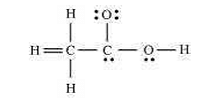Write Lewis symbols for the following atoms and ions: \(S\) and \(S ^{2-}\) ; \(Al\) and \(Al ^{3+}\) ; \(H\) and \(H ^-\)
Solution and Explanation
(i) \(S\) and \(S ^{2-}\)
The number of valence electrons in \(sulphur\) is \(6\).
The Lewis dot symbol of \(sulphur\) \((S)\) is . 
The dinegative charge infers that there will be two electrons more in addition to the six valence electrons.
Hence, the Lewis dot symbol of \(S ^{2-}\) is . 
(ii) \(Al\) and \(Al ^{3+}\)
The number of valence electrons in \(aluminium\) is \(3\).
The Lewis dot symbol of \(aluminium\) \((Al)\) is . 
The tripositive charge on a species infers that it has donated its three electrons.
Hence, the Lewis dot symbol is 
(iii) \(H\) and \(H ^-\)
The number of valence electrons in \(hydrogen\) is \(1\).
The Lewis dot symbol of \(hydrogen\) \((H)\) is 
The uninegative charge infers that there will be one electron more in addition to the one valence electron.
Hence, the Lewis dot symbol is 
Top Questions on Kossel-Lewis Approach to Chemical Bonding
- Which one follow 18 electron octet rule:
- JIPMER MBBS - 2019
- Chemistry
- Kossel-Lewis Approach to Chemical Bonding
- Write the resonance structures for SO3 , NO2 and NO3-
- CBSE Class XI
- Chemistry
- Kossel-Lewis Approach to Chemical Bonding
Draw the Lewis structures for the following molecules and ions: \(H_2S\), \(SiCl_4\), \(BeF_2\), \(CO_3^{2-}\) , \(HCOOH\)
- CBSE Class XI
- Chemistry
- Kossel-Lewis Approach to Chemical Bonding
- The skeletal structure of CH3COOH as shown below is correct, but some of the bonds are shown incorrectly. Write the correct Lewis structure for acetic acid.

- CBSE Class XI
- Chemistry
- Kossel-Lewis Approach to Chemical Bonding
- Use Lewis symbols to show electron transfer between the following atoms to form cations and anions:
- K and S
- Ca and O
- Al and N.
- CBSE Class XI
- Chemistry
- Kossel-Lewis Approach to Chemical Bonding
Questions Asked in CBSE Class XI exam
Figure 8.9 shows the strain-stress curve for a given material. What are (a) Young’s modulus and (b) approximate yield strength for this material?

- CBSE Class XI
- Stress-strain curve
- Arrange the bonds in order of increasing ionic character in the molecules: LiF, K2O, N2, SO2 and ClF3.
- CBSE Class XI
- Molecular Orbital Theory
- Three reasons why the author’s grandmother was disturbed when he started going to the city school.
- CBSE Class XI
- The Portrait of a lady
Two identical ball bearings in contact with each other and resting on a frictionless table are hit head-on by another ball bearing of the same mass moving initially with a speed V. If the collision is elastic, which of the following (Fig. 5.14) is a possible result after collision ?

- CBSE Class XI
- Collisions
- Why is it necessary to use acetic acid and not sulphuric acid for acidification of sodium extract for testing sulphur by lead acetate test?
- CBSE Class XI
- Organic Chemistry